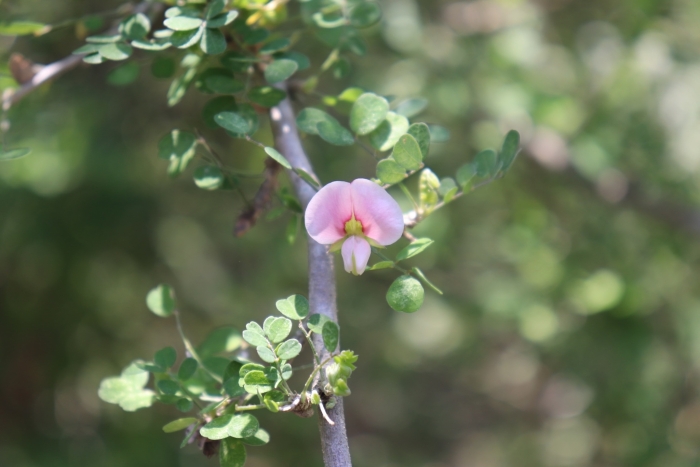Texas Babybonnets
(Coursetia axillaris)
Texas Babybonnets (Coursetia axillaris)
/
/

Claudio Cantú Muñiz
CC BY 4.0
Image By:
Claudio Cantú Muñiz
Recorded By:
Copyright:
CC BY 4.0
Copyright Notice:
Photo by: Claudio Cantú Muñiz | License Type: CC BY 4.0 | License URL: http://creativecommons.org/licenses/by/4.0/ | Rights Holder: Claudio Cantú Muñiz | Publisher: iNaturalist | Date Created: 2020-09-19T22:56:37Z |





















Estimated Native Range
Summary
Coursetia axillaris, commonly known as Texas Babybonnets, is an evergreen shrub native to the chaparral, scrublands, and open woodlands of the Gulf Coast region, Northeast Mexico, and Texas. It typically grows to a height of 6-9 feet (1.8-2.7 meters) and a width of 3-5 feet (0.9-1.5 meters). The plant has a rounded form with dense foliage and produces a profusion of pea-like flowers that are white, yellow, and pink, blooming in the winter and spring, which are moderately showy and attract pollinators.
Texas Babybonnets is valued for its drought tolerance and ability to thrive in poor soils, making it a suitable choice for xeriscaping and naturalistic plantings. It is often used in residential landscapes, as a border shrub, or for erosion control on slopes. This shrub prefers full sun to part shade and requires minimal water once established, making it low maintenance. It is adaptable to a range of soil types, provided they have medium to slow drainage. While generally disease-resistant, it can be susceptible to root rot if overwatered.CC BY-SA 4.0
Texas Babybonnets is valued for its drought tolerance and ability to thrive in poor soils, making it a suitable choice for xeriscaping and naturalistic plantings. It is often used in residential landscapes, as a border shrub, or for erosion control on slopes. This shrub prefers full sun to part shade and requires minimal water once established, making it low maintenance. It is adaptable to a range of soil types, provided they have medium to slow drainage. While generally disease-resistant, it can be susceptible to root rot if overwatered.CC BY-SA 4.0
Plant Description
- Plant Type: Shrub
- Height: 6-9 feet
- Width: 3-5 feet
- Growth Rate: Moderate
- Flower Color: White, Yellow, Pink
- Flowering Season: Winter, Spring
- Leaf Retention: Evergreen
Growth Requirements
- Sun: Full Sun, Part Shade
- Water: Low
- Drainage: Medium, Slow
Common Uses
Bee Garden, Border Plant, Butterfly Garden, Low Maintenance
Natural Habitat
Native to chaparral, scrublands, and open woodlands of the Gulf Coast region, Northeast Mexico, and Texas
Other Names
Common Names:
Scientific Names: , Coursetia axillaris,
GBIF Accepted Name: Coursetia axillaris J.M.Coult. & Rose